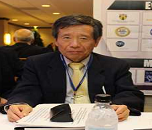
Masaru Matsuo
Dalian University of Technology, China
Title: Dynamic tensile modulus of positive temperature coefficient materials under electric field investigated in terms of low frequency earthquake counter measures
Biography
Biography: Masaru Matsuo
Abstract
PTC materials play important roles in promoting significant applications to floor heating and loft heating in order to get rid of snow removing by humans. To assure comfortable daily living in winter, the cost effective floor heating and loft heating must be established. Obviously, light PTC materials as heating elements have advantages for saving construction cost of building circulation rather than heavy hot water tubes in addition to the safety and cleanliness. Recently, PTC materials for floor heating and loft heating tend to be adopted on designing rooms in an apartment building. However, when earthquake with low frequency generate in winter, the residents must consider the serious damages. Certainly, since the serious damage of bank building by low frequency earthquake (0.1~2 Hz) at Mexico in 1985, the horrors of low-frequency earthquake have been investigated in terms to predominant period of ground and natural frequency of the construction materials relating to building height. Accordingly, the serious damages of recent buildings tend to decrease by the new design methods for preventing collapse of constructions. Different from such earthquake counter measures, however, there is no report on the damage of PTC materials against low-frequency earthquake, since no experimental method has been established for the frequency dependence of mechanical properties under applied electric fields. This presentation is focused on frequency dependence of the complex dynamic tensile modulus of PTC materials under applied electric field. Fine home-made attachments were fixed on a commercial visco-elastic spectrometer to measure the modulus with different frequencies at the desired temperatures. Efforts were done to determine static strain in order to place the sample in tension during axial sinusoidal oscillation. The measurements were carried out for ultra-high molecular weight polyethylene (UHMWPE)-nickel (Ni) coated carbon fiber (NiCF) composites which have been adopted as PTC materials. The drastic descent of the storage modulus was confirmed in lower frequency range (0.01~2 Hz) at surface temperature (Ts) elevated by Joule heat. That is, storage modulus by self-heating is much lower than that by external heating at the same temperature. This tendency became considerable beyond 65°C. The
composite was cut when Ts was beyond 93°C. In contrast, the cutting did not occur in higher frequency range (100~10 Hz) at Ts=105°C. The present fundamental work warns that protection of PTC materials used as floor heating must be taken into consideration in terms of low frequency earthquake in addition of the seismic intensity.

